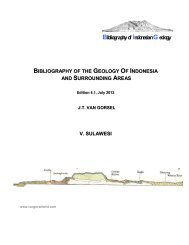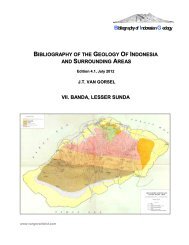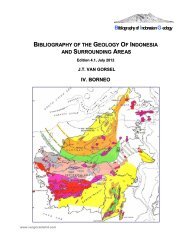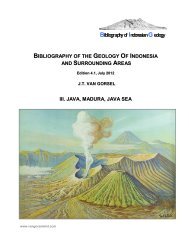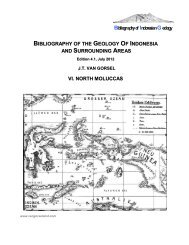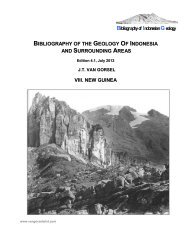Sumatra, Sunda Shelf, Natuna - Bibliography of Indonesia Geology
Sumatra, Sunda Shelf, Natuna - Bibliography of Indonesia Geology
Sumatra, Sunda Shelf, Natuna - Bibliography of Indonesia Geology
Create successful ePaper yourself
Turn your PDF publications into a flip-book with our unique Google optimized e-Paper software.
Salvador, P., W.R. Morris, R.J. Morley, M. Gunarto, R. Adhyaksawan & M. Challis (2008)- Managing<br />
reservoir uncertainty at the North Belut Field, Offshore <strong>Indonesia</strong>, <strong>Natuna</strong> Sea: an integrated analysis <strong>of</strong><br />
biostratigraphy, core, wireline and seismic data. Proc. 32 nd Ann. Conv. Indon. Petrol. Assoc., IPA08-G-205,<br />
14p.<br />
(Reservoir study <strong>of</strong> North Belut gas field in Udang and Gabus sands. 1500 ft section <strong>of</strong> thin, stacked lacustrine<br />
and deltaic sands with significant variation in vertical and lateral reservoir development)<br />
Sangree, J.B. (1981)- Use <strong>of</strong> seismic stratigraphy in carbonate rocks, <strong>Natuna</strong> D-Alpha Block Example. Proc.<br />
10th Ann. Conv. Indon. Petrol. Assoc., p. 135-152.<br />
(<strong>Natuna</strong> D-Alpha "L" structure large Late Miocene reef complex, 5,250’ gas column, 67%- 82%CO2. Arang<br />
Fm considered source <strong>of</strong> methane; CO2 believed to be from deep igneous activity. E-M Miocene Arang and<br />
Barat-Gabus shale widespread and uniform thickness, suggesting stable nonmarine-shallow marine shelf<br />
conditions. Post-Arang normal faulting resulted in rotation and faulting <strong>of</strong> "L" structure and Terumbu (U<br />
Miocene) carbonate development Further downfaulting in Lt Miocene- E Pliocene resulted in widespread<br />
carbonate deposits with local reef development on W shelf area and local buildups on crest <strong>of</strong> 'L' structure)<br />
Satriawan, R.W., T. Read & H. Baskara (2005)- Applying seismic attribute analysis and inversion techniques to<br />
understand the trapping mechanism in the Gajah Abu Abu Field, West <strong>Natuna</strong> Offshore. Proc. 30 th Ann. Conv.<br />
Indon. Petrol. Assoc., 1, p. 135- 144.<br />
(Gajah Abu Abu field in W <strong>Natuna</strong> Basin 1992 discovery in faulted Late Miocene inversion anticline.<br />
Significant stratigraphic component in Gajah Abu Abu trap)<br />
Subono, S, Siswoyo & A. Firman (1995)- Heat flow in border areas <strong>of</strong> <strong>Indonesia</strong>, Malaysia and Vietnam. In: J.<br />
Ringis (ed.) Proc. 31st Sess. Comm. Co ord. Joint Prospecting Min. Res. Asian Offshore Areas (CCOP), Kuala<br />
Lumpur 1994, 2, p. 59-75.<br />
(Mainly on heatflow from 46 wells in West and 24 wells in East <strong>Natuna</strong> basins. Av. T gradient 39.7 °C/km)<br />
Sugihardjo, S.S. Aprilian, A. Yusuf & S Sumardan (2000)- Investigations <strong>of</strong> the storage efficiency <strong>of</strong> CO2 in<br />
carbonate aquifers. Proc. 27th Ann. Conv. Indon. Petrol. Assoc., 2, p. 79-93.<br />
Suryono, N. (1997)- Analisa struktur P. Laut dan P. Sekatung, Kepulauan <strong>Natuna</strong> besar. J. Geol. Sumberdaya<br />
Min. 7, 74, p. 2-24.<br />
('Analysis <strong>of</strong> the structure <strong>of</strong> the Laut and Sekatung islands, <strong>Natuna</strong> Besar island group')<br />
Sutoto, A. (1991)- Reservoir geology <strong>of</strong> the Belida Field South <strong>Natuna</strong> Sea, Block B. Proc. 20th Ann. Conv.<br />
Indon. Petrol. Assoc., 1, p. 453-478.<br />
(1989 Conoco Belida oil field with 187 MBO and 130 BCF gas. Trap four-way closure, a structural inversion <strong>of</strong><br />
half-graben during E Miocene (later?; HvG) regional compression. Age <strong>of</strong> sediments over Cretaceous granite<br />
Oligocene- Holocene. Oil reservoirs Oligocene Udang and E Miocene Lower Arang Sands, gas in E Miocene<br />
Arang Fm. Udang Fm sands stacked fluvial channels, Lower Arang sands distributary mouth bars in<br />
progadational lacustrine delta. Good vertical and lateral reservoir continuity. Sands ~30% porosity)<br />
Thamrin, M., Prayitno, S. Tiwar & Solichin (1983)- Heatflow investigation in the Tertiary basins <strong>of</strong> <strong>Natuna</strong><br />
Sea. Proc. 19 th Sess. CCOP, Tokyo 1982, 2, Techn. Repts., p. 153-166.<br />
(Heatflow data from 29 wells in <strong>Indonesia</strong>n sector <strong>of</strong> <strong>Natuna</strong> Sea. Heatflow in W area <strong>of</strong> <strong>Natuna</strong> Arch (av. 2.03<br />
HFU, T gradient av. 3.45 248 °C/100m) higher than in E (av. 1.59 HFU, T gradient av. 3.36 °C/100m))<br />
Tjia, H.D. (1997)- Regional northwest to west-northwest lineaments in the southern part <strong>of</strong> the South China Sea<br />
Basin. Warta Geologi, Geol. Soc. Malaysia Newsl. 23, 5, p. 297-302.<br />
Van Mechelen, G., J. Meyer & R. Gir (1998)- Correlation mapping technique, a powerful tool to minimize risk<br />
and to guide future development plans. Proc. 26th Ann. Conv. Indon. Petrol. Assoc., p. 175-196.<br />
(Geophysical study over two gas fields in W <strong>Natuna</strong> Basin)<br />
<strong>Bibliography</strong> <strong>of</strong> <strong>Indonesia</strong> <strong>Geology</strong> v. 4.1 151 www.vangorselslist.com July 2012



